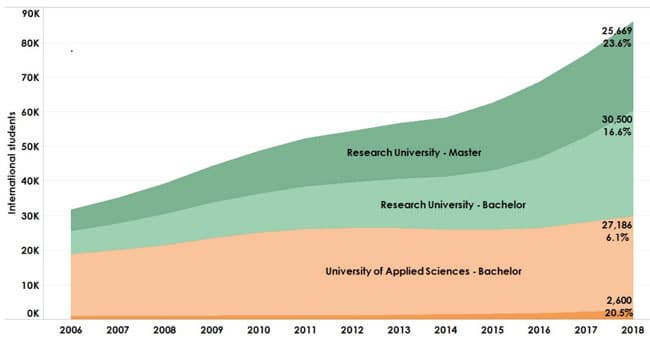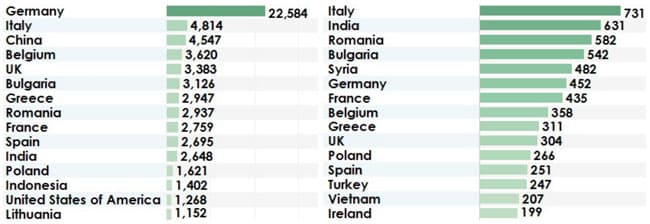Foreign enrolment continues to grow in the Netherlands
The latest data from the Dutch organisation for internationalisation in education – Nuffic – highlights a further increase in degree-seeking international students in the Netherlands for 2018/19.
Nuffic reports that there were 85,955 foreign students from 170 countries enrolled in degree programmes in public institutions in the Netherlands in the 2018/19 academic year. There are two dimensions of growth reflected in this: overall student numbers have increased by just over 12% from 2017/18 and the proportion of international students in Dutch higher education has also risen to 11.5% this year, compared to 10.5% the year before.
The qualifications in these top-line findings are also important. First, this figure reflects only degree-seeking students, as opposed to “credit mobility” – that is, those who visit the Netherlands or an internship or for a semester or year abroad programme – nor does it reflect any enrolment outside of the public higher education system.
As such, and as the following chart reflects, the Nuffic report is quite squarely focused on three bands of degree enrolment: undergraduate programmes at universities of applied sciences and then undergraduate and graduate programmes at Dutch research universities.

Where do students come from?
Nearly three in four foreign students in the Netherlands (73% or 62,932 students) came from European Economic Area (EEA) countries, with the balance coming from outside the EEA. The share of non-EEA students is increasing steadily over the last two years, however, rising from 25% in 2016/17 to 27% in 2018/19.
As the following table reflects, Germany remains, by far, the leading sending market for Dutch higher education. For the last three years, however, Italy has been the fastest-growing market for the Netherlands and it surpassed China as the second-largest sender for the first time in 2018/19. India, Romania, Bulgaria, and Syria round out the top five growth markets this year.

Social license
The growing numbers of international students in the Netherlands, their increasing proportion among the country’s higher education population, and the corresponding demand for English-taught programmes has triggered significant public debate in the country. At various points throughout 2018, the Dutch government signalled its continued commitment to internationalisation but government ministers have also indicated that further conditions or oversight may be placed on higher education institutions in the Netherlands going forward. Nuffic acknowledges the current political climate in the opening paragraphs of the report: “The inflow of international students has been a central topic of public debate in the last couple of years. The Dutch Ministry of Education and the Dutch universities’ associations…agree that internationalisation contributes to the quality of education and Dutch society in general, recognising, however, that it also creates challenges related to housing, language policy and accessibility of education.” “We hope that this annual report will help policymakers and other decision makers to arrive at evidence based decisions.” For additional background, please see:
Most Recent
-
ICEF Podcast: Together for transparency – Building global standards for ethical international student recruitment Read More
-
New analysis sounds a note of caution for UK immigration reforms Read More
-
The number of students in higher education abroad has more than tripled since the turn of the century Read More


















